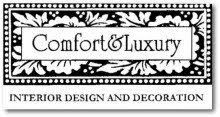 Welcome to the 2nd Mood Board Monday! And thanks to PK at Room Remix for asking me to host this time...
Welcome to the 2nd Mood Board Monday! And thanks to PK at Room Remix for asking me to host this time... ... she also asked me to choose the inspiration items. My picks: Anthropologie's Antwerp and Bertram chairs. Here's my own mood board, then we'll take a look at the others...
... she also asked me to choose the inspiration items. My picks: Anthropologie's Antwerp and Bertram chairs. Here's my own mood board, then we'll take a look at the others...My first inclination was to choose the curvy, flowery Antwerp chair. So I chose Bertram instead. Just to step out of my comfort zone a bit. Then, as I do before I start working on a mock mood board, I imagined my clients and their story.
MY CLIENTS: A young, professional couple who live in a city apartment they bought right after they married three years ago. They each put in a long work week, spending most evenings eating a late meal out or scrounging something quick in the kitchen. They do like to dine with other couples on weekends and would like to do more of that, plus some business entertaining, at their own home more often. With no children yet, their apartment reflects their young, upwardly mobile, traditional-with-a-contemporary-twist aesthetic.
THE SPACE: The dining room. Largely ignored because of their busy lifestyle and work schedules, it's finally getting some attention. My clients would like to serve cocktails, seat 6-8 people for dinner and will primarily use the room at night. Budget-minded purchases will be at the core of the design, but driving it will be the pair of Bertram chairs they've decided to splurge on.
THE MOOD BOARD:
young professionals' dinner party by Comfort&Luxury on Polyvore.com
THE DETAILS:Bertram Chairs from Anthropologie.
Covington Side Chairs from Bassett. Seats will be reupholstered in
Shalimar Sateen Hyacinth fabric in purple (the swatch nearest the side chair) from Calico Corners.
Laurent Table from Crate & Barrel.
Steamer Bar Cabinet from Crate & Barrel.
Sullivan Charcoal Rug, 10'x14', from Crate & Barrel.
Polished Chrome Chandelier by Quoizel from Lamps Plus.
Polished Nickel Sconces by Sheffield from Lamps Plus will be placed in pairs; one pair on either side of the mirror over the bar cabinet and the other pair on the opposite wall on either side of the art that will hang there. (see it below)
Le Soleil Wall Mirror from Home Decorators Collection hangs over the bar cabinet.
Titan Pewter Silk in Gray/Silver from Calico Corners (the swatch you see next to the mirror)is used for custom curtain panels.
Purple Damask Wallpaper from Graham & Brown is used on all four walls.
Ruby Crystal Wine Glasses, a wedding gift, are paired with simple
Glass Water Goblets from Crate & Barrel.
Rounding out the table setting is the couple's Royal Doulton wedding china, which not only brings a bit of sparkle with its platinum banding but another bit of subtle color: salad plates have pale blue rims.

Here's a better look at the bar cabinet, opened to show off its sleek, practical design and copious capacity.

And because the tiny pic on the mood board doesn't so it justice, here's a close-up of the chandelier.

Hanging on the wall opposite the bar cabinet will be a large, framed poster the couple already owned. A souvenir from their honeymoon in New York, this image of acrobats defying death at the edge of a rooftop overlooking the city presents a quirkier view than the usual cityscape of a place that holds fond memories.

As dining room chairs, the Bertram armchairs might not be the most practical choice, but they make a great style statement in a space that doesn't get daily use. They're also quite pricey, so I would suggest my clients extend their lives in this way: when they start a family and move to a house in the 'burbs, the chairs can move into the family room. The gray area rug can follow the chairs... it's a hard-wearing, neutral color. Other more colorful, family-friendly pieces can be added to create a lively, happy mix. New host chairs, perhaps a slipcovered parsons style, can take their place in the new dining room. Even the bar cabinet might take on a new life as storage and display space in the family room or entry. And I can see it painted a bright, fun color like shiny lacquer red.
Okay, that's mine... now let's see who else is linking up!
Here's what you do to join the party:
1) Create a mood board using either of the inspiration chairs. (both from Anthropologie) 2) Write a a post about it, including sources. 3) Add your name and project to MckLinky here on my post (Example: Tracy's Dining Room Mood Board)... 4) ...then add the link to your SPECIFIC POST, NOT your general blog address.  5) Last, grab the Mood Board Monday button (above) and use it to link your post back to this post so that everyone gets to join in the party!
5) Last, grab the Mood Board Monday button (above) and use it to link your post back to this post so that everyone gets to join in the party!



























































































































































